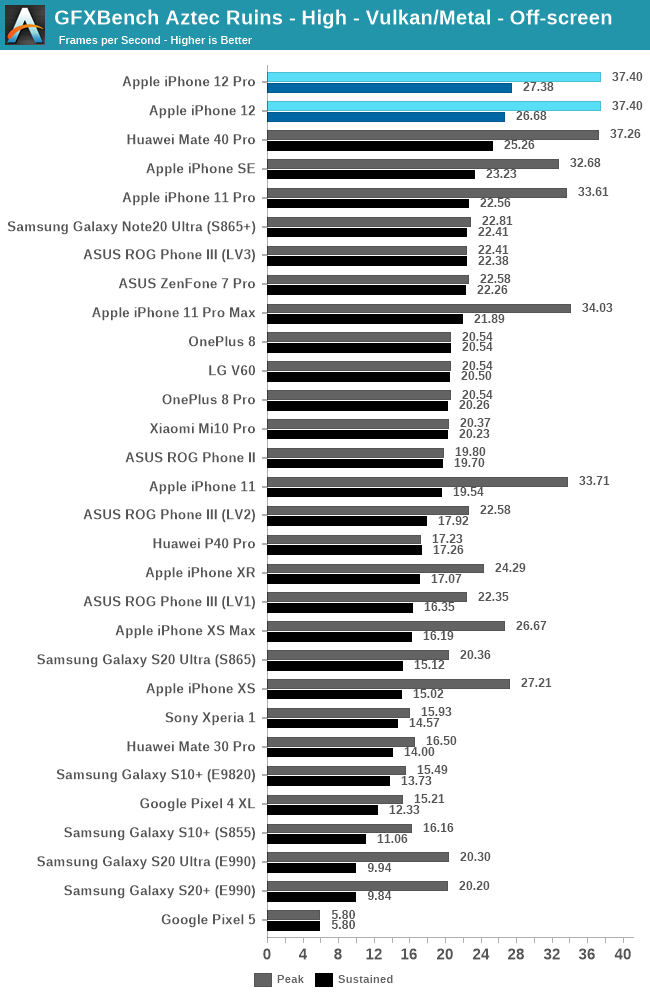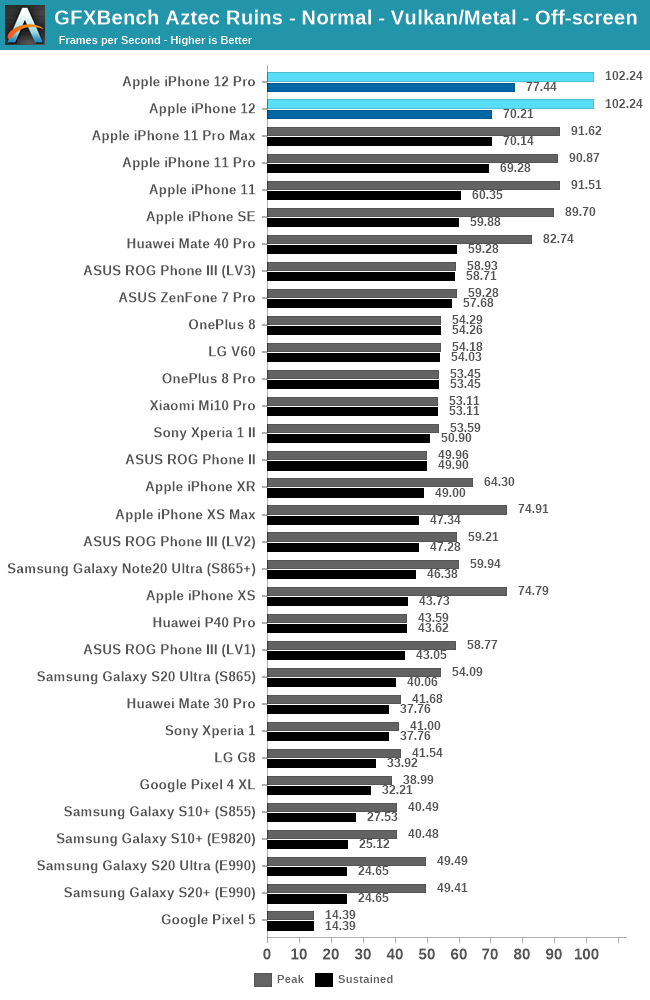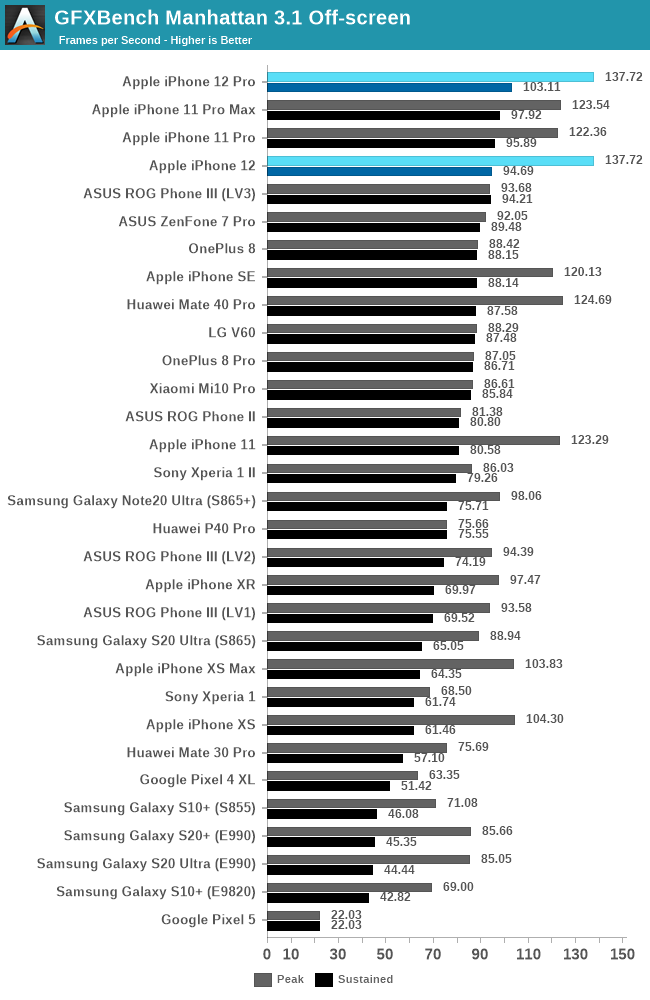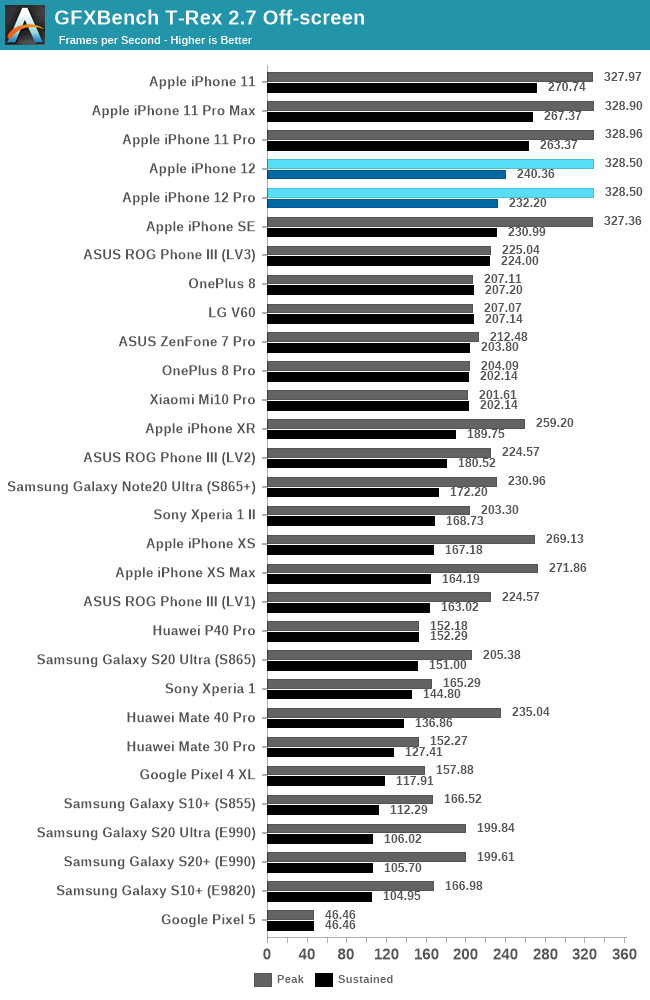The iPhone 12 & 12 Pro Review: New Design and Diminishing Returns
by Andrei Frumusanu on November 30, 2020 8:30 AM EST- Posted in
- Mobile
- Apple
- Smartphones
- Apple A14
- iPhone 12
- iPhone 12 Pro
GPU Performance & Power
GPU performance of the new A14 is something that wasn’t very clearly presented during the launch of the new iPhone 12 series. Apple had first introduced the A14 within the new iPad series where it had promised performance increases relative to the A12, not the previous generation A13, and with a bit of math this resulted into a translated 8.3% generational increase which is rather smaller than we had expected given Apple’s recent GPU trajectory over the years. Furthermore, this was also the first release where Apple compared itself to the Android SoC competition which is something the company doesn’t usually do. All these factored into some rather low expectations for the GPU of the A14 – so let’s see how that pans out in practice:

Starting off with Basemark GPU 1.2, we’re seeing a 17% increase in peak performance relative to the iPhone 11 Pro and the A13 chip, which is a nice upgrade, but doesn’t tell the whole story. In the sustained performance figure after 30 minutes of running and when the phone reaches a thermal equilibrium, we see a 45% drop in performance. In this instance, it looks like the iPhone 12 Pro reached a lower sustained performance level than the iPhone 11 Pro which isn’t a great start, but that might change with differing workloads.

In the Aztec High test, the iPhone 12’s fare a bit better in their sustained performances, with the new chip showing a 21% increase in performance generationally. The peak performance figure is only 11% higher but generally this isn’t the figure that is important for gaming experiences on iPhones.
| GFXBench Aztec High Offscreen Power Efficiency (System Active Power) |
||||
| Mfc. Process | FPS | Avg. Power (W) |
Perf/W Efficiency |
|
| iPhone 12 Pro (A14) 🔥 Throttled | N5 | 28.36 | 3.91 | 7.24 fps/W |
| iPhone 11 Pro (A13) 🔥 Throttled | N7P | 26.14 | 3.83 | 6.82 fps/W |
| iPhone 12 Pro (A14) ❄️ Peak | N5 | 37.40 | 5.57 | 6.64 fps/W |
| iPhone 11 Pro (A13) ❄️ Peak | N7P | 34.00 | 6.21 | 5.47 fps/W |
| Galaxy S20 Ultra (Snapdragon 865) | N7P | 20.35 | 3.91 | 5.19 fps/W |
| Mate 40 Pro (Kirin 9000) 🔥 Throttled | N5 | 27.37 | 5.39 | 5.07 fps/W |
| iPhone XS (A12) 🔥 Throttled | N7 | 19.32 | 3.81 | 5.07 fps/W |
| Reno3 5G (Dimensity 1000L) | N7 | 11.93 | 2.39 | 4.99 fps/W |
| iPhone XS (A12) ❄️ Peak | N7 | 26.59 | 5.56 | 4.78 fps/W |
| Mate 40 Pro (Kirin 9000) ❄️ Peak | N5 | 37.22 | 8.53 | 4.36 fps/W |
| ROG Phone III (Snapdragon 865+) | N7P | 22.34 | 5.35 | 4.17 fps/W |
| Mate 30 Pro (Kirin 990 4G) | N7 | 16.50 | 3.96 | 4.16 fps/W |
| Galaxy S20+ (Exynos 990) | 7LPP | 20.20 | 5.02 | 3.59 fps/W |
| Galaxy S10+ (Snapdragon 855) | N7 | 16.17 | 4.69 | 3.44 fps/W |
| Galaxy S10+ (Exynos 9820) | 8LPP | 15.59 | 4.80 | 3.24 fps/W |
Looking at the power consumption of the new phones, we see again that both the peak and throttled performance figures of the new chip isn’t all that much different to the previous generation, as we’re seeing roughly 8% better performance at almost the same power envelope of around 3.9W. The peak power figure of the new chip seems to have been reduced this generation and that’s very much a welcome change, and that’s where the efficiency sees the largest delta to the A13.

In the normal setting configuration of the Aztec test, we’re seeing again a 11% increase in sustained performance generationally, and a similar 12% boost in peak performance. These are good improvements but still a bit less than we had expected given the A14’s new process node and new GPU.
| GFXBench Aztec Normal Offscreen Power Efficiency (System Active Power) |
||||
| Mfc. Process | FPS | Avg. Power (W) |
Perf/W Efficiency |
|
| iPhone 12 Pro (A14) 🔥 Throttled | N5 | 77.44 | 3.88 | 19.95 fps/W |
| iPhone 12 Pro (A14) ❄️ Peak | N5 | 102.24 | 5.53 | 18.48 fps/W |
| iPhone 11 Pro (A13) 🔥 Throttled | N7P | 73.27 | 4.07 | 18.00 fps/W |
| iPhone 11 Pro (A13) ❄️ Peak | N7P | 91.62 | 6.08 | 15.06 fps/W |
| iPhone XS (A12) 🔥 Throttled | N7 | 55.70 | 3.88 | 14.35 fps/W |
| Galaxy S20 Ultra (Snapdragon 865) | N7P | 54.09 | 3.91 | 13.75 fps/W |
| iPhone XS (A12) ❄️Peak | N7 | 76.00 | 5.59 | 13.59 fps/W |
| Reno3 5G (Dimensity 1000L) | N7 | 27.84 | 2.12 | 13.13 fps/W |
| Mate 40 Pro (Kirin 9000) 🔥 Throttled | N5 | 63.56 | 5.37 | 11.84 fps/W |
| ROG Phone III (Snapdragon 865+) | N7P | 58.77 | 5.34 | 11.00 fps/W |
| Mate 40 Pro (Kirin 9000) ❄️ Peak | N5 | 82.74 | 7.95 | 10.40 fps/W |
| Mate 30 Pro (Kirin 990 4G) | N7 | 41.68 | 4.01 | 10.39 fps/W |
| Galaxy S20+ (Exynos 990) | 7LPP | 49.41 | 4.87 | 10.14 fps/W |
| Galaxy S10+ (Snapdragon 855) | N7 | 40.63 | 4.14 | 9.81 fps/W |
| Galaxy S10+ (Exynos 9820) | 8LPP | 40.18 | 4.62 | 8.69 fps/W |
The power figures showcase a similar generational movement, with a slight performance increase at a slight power decrease. It’s good progression but again not quite fulfilling our expectations of a new process node bump.

| GFXBench Manhattan 3.1 Offscreen Power Efficiency (System Active Power) |
||||
| Mfc. Process | FPS | Avg. Power (W) |
Perf/W Efficiency |
|
| iPhone 12 Pro (A14) 🔥 Throttled | N5 | 103.11 | 3.90 | 26.43 fps/W |
| iPhone 12 Pro (A14) ❄️ Peak | N5 | 137.72 | 5.63 | 24.46 fps/W |
| iPhone 11 Pro (A13) 🔥 Throttled | N7P | 100.58 | 4.21 | 23.89 fps/W |
| Galaxy S20 Ultra (Snapdragon 865) | N7P | 88.93 | 4.20 | 21.15 fps/W |
| iPhone 11 Pro (A13) ❄️Peak | N7P | 123.54 | 6.04 | 20.45 fps/W |
| iPhone XS (A12) 🔥 Throttled | N7 | 76.51 | 3.79 | 20.18 fps/W |
| Reno3 5G (Dimensity 1000L) | N7 | 55.48 | 2.98 | 18.61 fps/W |
| Mate 40 Pro (Kirin 9000) 🔥 Throttled | N5 | 87.31 | 4.98 | 17.54 fps/W |
| iPhone XS (A12) ❄️Peak | N7 | 103.83 | 5.98 | 17.36 fps/W |
| ROG Phone III (Snapdragon 865+) | N7P | 93.58 | 5.56 | 16.82 fps/W |
| Mate 40 Pro (Kirin 9000) ❄️Peak | N5 | 124.69 | 8.28 | 15.05 fps/W |
| Mate 30 Pro (Kirin 990 4G) | N7 | 75.69 | 5.04 | 15.01 fps/W |
| Galaxy S20+ (Exynos 990) | 7LPP | 85.66 | 5.90 | 14.51 fps/W |
| Galaxy S10+ (Snapdragon 855) | N7 | 70.67 | 4.88 | 14.46 fps/W |
| Galaxy S10+ (Exynos 9820) | 8LPP | 68.87 | 5.10 | 13.48 fps/W |
| Galaxy S9+ (Snapdragon 845) | 10LPP | 61.16 | 5.01 | 11.99 fps/W |
| Mate 20 Pro (Kirin 980) | N7 | 54.54 | 4.57 | 11.93 fps/W |
| Galaxy S9 (Exynos 9810) | 10LPP | 46.04 | 4.08 | 11.28 fps/W |
| Galaxy S8 (Snapdragon 835) | 10LPE | 38.90 | 3.79 | 10.26 fps/W |
| Galaxy S8 (Exynos 8895) | 10LPE | 42.49 | 7.35 | 5.78 fps/W |
Depending on the workload, the generational performance increases can be even smaller, as here in Manhattan the performance increase in a throttled state is only 3% better for the new A14 based iPhone, with also a minor power decrease at this state.

| GFXBench T-Rex Offscreen Power Efficiency (System Active Power) |
||||
| Mfc. Process | FPS | Avg. Power (W) |
Perf/W Efficiency |
|
| iPhone 12 Pro (A14) 🔥 Throttled | N5 | 260.28 | 4.08 | 63.97 fps/W |
| iPhone 11 Pro (A13) 🔥 Throttled | N7P | 289.03 | 4.78 | 60.46 fps/W |
| iPhone 12 Pro (A14) ❄️ Peak | N5 | 328.50 | 5.55 | 59.18 fps/W |
| iPhone 11 Pro (A13) ❄️ Peak | N7P | 328.90 | 5.93 | 55.46 fps/W |
| Galaxy S20 Ultra (Snapdragon 865) | N7P | 205.37 | 3.83 | 53.30 fps/W |
| Mate 40 Pro (Kirin 9000) 🔥 Throttled | N5 | 147.13 | 2.92 | 50.38 fps/W |
| iPhone XS (A12) 🔥 Throttled | N7 | 197.80 | 3.95 | 50.07 fps/W |
| ROG Phone III (Snapdragon 865+) | N7P | 224.48 | 4.92 | 45.60 fps/W |
| iPhone XS (A12) ❄️Peak | N7 | 271.86 | 6.10 | 44.56 fps/W |
| Galaxy 10+ (Snapdragon 855) | N7 | 167.16 | 4.10 | 40.70 fps/W |
| Reno3 5G (Dimensity 1000L) | N7 | 139.30 | 3.57 | 39.01 fps/W |
| Mate 40 Pro (Kirin 9000) ❄️ Peak | N5 | 235.04 | 6.11 | 38.46 fps/W |
| Galaxy S20+ (Exynos 990) | 7LPP | 199.61 | 5.63 | 35.45 fps/W |
| Mate 30 Pro (Kirin 990 4G) | N7 | 152.27 | 4.34 | 35.08 fps/W |
| Galaxy S9+ (Snapdragon 845) | 10LPP | 150.40 | 4.42 | 34.00 fps/W |
| Galaxy 10+ (Exynos 9820) | 8LPP | 166.00 | 4.96 | 33.40fps/W |
| Galaxy S9 (Exynos 9810) | 10LPP | 141.91 | 4.34 | 32.67 fps/W |
| Galaxy S8 (Snapdragon 835) | 10LPE | 108.20 | 3.45 | 31.31 fps/W |
| Mate 20 Pro (Kirin 980) | N7 | 135.75 | 4.64 | 29.25 fps/W |
| Galaxy S8 (Exynos 8895) | 10LPE | 121.00 | 5.86 | 20.65 fps/W |
Finally, T-Rex showcases no improvements on the part of peak performance figures, although it does lower power consumption, and sustained performance for some reason is lower on the newer generation iPhone, although again it showcases quite lower power consumption so it’s possible the new chip is mainly running on the efficiency CPU cores in this workload.
Reasonable Upgrades
Generally speaking, our concerns over Apple’s lacklustre marketing on the GPU side of things seem to have been warranted as the new A14 and the 5nm process node doesn’t seem to bring substantial gains this generation. Performance is a little higher, and efficiency has also gone up as well, but it’s nowhere near the levels of improvements that Apple had been able to achieve with the A12 and A13. On one side that’s pretty understandable as those two generations had made huge leaps, and on the other hand it was maybe unreasonable to expect Apple to continue to make such gigantic strides on every generation.
Overall, the new iPhone 12 devices and the A14 still offer the very best gaming performance of any smartphone out in the market, showcasing significantly better experiences than any other Android competitor, but it’s also not a major noticeable upgrade over the iPhone 11 series devices.










101 Comments
View All Comments
DejayC - Monday, November 30, 2020 - link
I find the flat edges of my iPhone 12 mini to be easier to grip on to than the curved edges of the older iPhones.FunBunny2 - Monday, November 30, 2020 - link
I was just about to post just that. could it be that short people with small hands are the only ones to complain about flat edged phones (and other things)? those for 4 edges, intelligently chamfered of course, are what give you purchased to hold on to that slippery thing.jeremyshaw - Monday, November 30, 2020 - link
I think completely flat edges work better on smaller phones. Mini, 5, 5S, 5C, etc. 4 and 4S as well. Though the 4 and 4S were "technically" flat, they did have the actual back and screen protruding enough to be a stepped approximation of a curved edge.xaneo - Saturday, December 26, 2020 - link
I'm jumping onto the flat edges bandwagon, all for it.milkywayer - Wednesday, December 2, 2020 - link
I still don't understand what makes the iPhone 12 worth ~$850 after tax compared to iPhone 11 that apples website is selling for $640~? Can someone explain?My biggest gripe with iOS is it kills my previous app pretty fast e.g. I could be watching YouTube or browsing a chrome tab but if I switch to reddit and or then whatsapp and then come back to the chrome or youtube, it'll make likely reload the entire app/page and I lose my progress.
I got tired of the small keyboard on my 2020 iphone SE and was going back and forth between picking iPhone 11 vs iPhone 12 and when I realized the 13 still has the same 4gb RAM, it was an easy decision going for the iphone 11 as both have the same display size and except for the tiny bit faster cpu which I probably wouldn't have noticed browsing chrome or reddit and the oled screen which isn't a big deal.
I couldn't justify spending almost 35-40% more for a tiny tiny upgrade.
What I would love for would be to get a bigger screen size like the pro max but apple has prices those out of my budget and most people's budgets I'd assume.
Frantisek - Friday, December 4, 2020 - link
I guess very durable screen on 12 can pay for itself.Speedfriend - Sunday, December 6, 2020 - link
Your point about iOS is one of the main reasons I don't use an iPhone. I day trade and iOS suspending apps in the background means that I have switched quickly to a trading app to check prices not realising they are totally out of date. Totally uselessblackcrayon - Thursday, December 10, 2020 - link
That sounds like that particular app doesn't work properly. Apps can refresh in the background, but even if not, why would it take more than a second to update from waking a suspended app?ZGamer - Monday, December 7, 2020 - link
12 Pro models ship with 6GB ram vs 4GB.As with everything it depends on which models your looking and how your looking to buy. If looking at purchasing outright for some of the mvno carriers or prepaid service the 11 is a better deal. If looking at deals with bill pay credits and other incentives it can be very cheap to get a 12.
Sales around Black Friday had the iPhone 12 for free with qualifying trade and bill pay credits....12 Pro for $99 and 12 Pro Max for $199 if you had the right set of circumstances (new line/port-in only for AT&T and Best Buy).
In general year or year performance gains are generally pretty small, it's the two to five year old devices that can see larger performance improvements.....and a fresh battery.
ebernet - Wednesday, December 9, 2020 - link
@milkywayer these are some of the reasons that would lead me to pick a 12 over an 11...1. The iPhone 11 is an LCD screen instead of OLED, with a 2x Retina display and 1792‑by‑828‑pixel resolution at 326 ppi. The 12 is OLED with a 3 pixel per point for 2532-by-1170-pixel resolution at 460 ppi. The OLED allows the screen to be closer to the edge. I would think that is the biggest reason.
2. Significantly better night mode
3. Only 32% more, not 35-40
There are a bunch of other reasons to choose the 12 over the 11, but for me the change from LCD to OLED at MUCH higher pixel resolution and a more durable screen is sufficient.
That being said, I am still on my XS Max and will be waiting for the 13. There were days when I would upgrade my iPhone EVERY year (original all the way through the 4S). As the curve of improvements slowed down I went to every other year (5S, 6S Plus). Now I am on a 3 year tick and the XS Max is plenty good enough for me. I am looking forward to HOPEFULLY some kind of better optical zoom in the iPhone 13. However, if this was my tock year I'd be going for a 12 Pro Max with 256, but if I had to choose between an 11 and a 12 it would be a NO brainer, much more than last year choosing between the 11 and the XR (much more of a valid comparison because they both shared very similar screens). The screen on the 12 is on its own worth the price delta between the 12 and 11.